Daytime Restricted Feeding Modifies the Temporal Expression of CYP1A1 and Attenuated Damage Induced by Benzo[a]pyrene in Rat Liver When Administered before CYP1A1 Acrophase
Abstract
1. Introduction
2. Materials and Methods
2.1. Chemicals
2.2. Animals
2.3. Animal Treatment
2.3.1. Daytime Restricted Feeding
2.3.2. Exposure to BaP
2.4. AhR, ARNT, and CYP1A1 Expression
2.5. Subcellular Fractionation
2.6. Protein Quantification
2.7. CYP1A1 Immunodetection
2.8. CYP1A1 Activity Assay
2.9. BPDE-DNA Assay
2.10. Serum Aspartate Aminotransferase (AST) and Alanine Aminotransferase (ALT) Activities
2.11. BaP Quantification Assay
2.12. Statistical Analysis
3. Results
3.1. Liver AhR, ARNT, and CYP1A1 Expression in ALF and DRF Groups
3.2. BaP Administration Time
3.3. DRF Attenuates the Induction of Hepatic CYP1A1 Expression by BaP
3.4. DRF Attenuated BPDE-DNA Adduct Levels in the Liver
3.5. DRF Attenuated Serum AST and ALT Activities after BaP Exposure
3.6. BaP Retention in the Liver
4. Discussion
Author Contributions
Funding
Institutional Review Board Statement
Informed Consent Statement
Data Availability Statement
Acknowledgments
Conflicts of Interest
References
- Wang, Z.; Yang, P.; Xie, J.; Lin, H.-P.; Kumagai, K.; Harkema, J.; Yang, C. Arsenic and benzo[a]pyrene co-exposure acts synergistically in inducing cancer stem cell-like property and tumorigenesis by epigenetically down-regulating SOCS3 expression. Environ. Int. 2020, 137, 105560. [Google Scholar] [CrossRef]
- Degrendele, C.; Audy, O.; Hofman, J.; Kučerik, J.; Kukucka, P.; Mulder, M.D.; Přibylová, P.; Prokeš, R.; Šáňka, M.; Schaumann, G.E.; et al. Diurnal Variations of Air-Soil Exchange of Semivolatile Organic Compounds (PAHs, PCBs, OCPs, and PBDEs) in a Central European Receptor Area. Environ. Sci. Technol. 2016, 50, 4278–4288. [Google Scholar] [CrossRef]
- Hecht, S.S. Tobacco smoke carcinogens and lung cancer. J. Natl. Cancer Inst. 1999, 91, 1194–1210. [Google Scholar] [CrossRef] [PubMed]
- Hayakawa, K. Environmental Behaviors and Toxicities of Polycyclic Aromatic Hydrocarbons and Nitropolycyclic Aromatic Hydrocarbons. Chem. Pharm. Bull. 2016, 64, 83–94. [Google Scholar] [CrossRef] [PubMed]
- Kawajiri, K.; Fujii-Kuriyama, Y. Cytochrome P450 gene regulation and physiological functions mediated by the aryl hydrocarbon receptor. Arch. Biochem. Biophys. 2007, 464, 207–212. [Google Scholar] [CrossRef] [PubMed]
- Ewa, B.; Danuta, M.Š. Polycyclic aromatic hydrocarbons and PAH-related DNA adducts. J. Appl. Genet. 2017, 58, 321–330. [Google Scholar] [CrossRef] [PubMed]
- Lee, H.M.; Chae, Y.H.; Kwon, C.; Kim, S.K. Conformations of adducts formed between the genotoxic benzo[a]pyrene-7,8-dione and nucleosides studied by density functional theory. Biophys. Chem. 2007, 125, 151–158. [Google Scholar] [CrossRef] [PubMed]
- Shimada, T.; Fujii-Kuriyama, Y. Metabolic activation of polycyclic aromatic hydrocarbons to carcinogens by cytochromes P450 1A1 and 1B1. Cancer Sci. 2004, 95, 1–6. [Google Scholar] [CrossRef]
- Verma, N.; Pink, M.; Rettenmeier, A.W.; Schmitz-Spanke, S. Review on proteomic analyses of benzo[a]pyrene toxicity. Proteomics 2012, 12, 1731–1755. [Google Scholar] [CrossRef] [PubMed]
- Richardson, V.M.; Santostefano, M.J.; Birnbaum, L.S. Daily cycle of bHLH-PAS proteins, Ah receptor and Arnt, in multiple tissues of female Sprague-Dawley rats. Biochem. Biophys. Res. Commun. 1998, 252, 225–231. [Google Scholar] [CrossRef]
- Tanimura, N.; Kusunose, N.; Matsunaga, N.; Koyanagi, S.; Ohdo, S. Aryl hydrocarbon receptor-mediated Cyp1a1 expression is modulated in a CLOCK-dependent circadian manner. Toxicology 2011, 290, 203–207. [Google Scholar] [CrossRef]
- Zmrzljak, U.P.; Rozman, D. Circadian regulation of the hepatic endobiotic and xenobitoic detoxification pathways: The time matters. Chem. Res. Toxicol. 2012, 25, 811–824. [Google Scholar] [CrossRef] [PubMed]
- Hirota, T.; Fukada, Y. Resetting mechanism of central and peripheral circadian clocks in mammals. Zoolog. Sci. 2004, 21, 359–368. [Google Scholar] [CrossRef] [PubMed]
- Cassone, V.M.; Stephan, F.K. Central and peripheral regulation of feeding and nutrition by the mammalian circadian clock: Implications for nutrition during manned space flight. Nutrition 2002, 18, 814–819. [Google Scholar] [CrossRef]
- Hirao, J.; Arakawa, S.; Watanabe, K.; Ito, K.; Furukawa, T. Effects of restricted feeding on daily fluctuations of hepatic functions including p450 monooxygenase activities in rats. J. Biol. Chem. 2006, 281, 3165–3171. [Google Scholar] [CrossRef]
- Rivera-Zavala, J.B.; Molina-Aguilar, C.; Pérez-Mendoza, M.; Olguín-Martínez, M.; Hernández-Muñoz, R.; Báez-Ruiz, G.A.; Díaz-Muñoz, M. Daytime restricted feeding modifies the daily regulation of fatty acid β-oxidation and the lipoprotein profile in rats. Br. J. Nutr. 2017, 117, 930–941. [Google Scholar] [CrossRef] [PubMed]
- Pérez-Mendoza, M.; Rivera-Zavala, J.B.; Díaz-Muñoz, M. Daytime restricted feeding modifies the daily variations of liver gluconeogenesis: Adaptations in biochemical and endocrine regulators. Chronobiol. Int. 2014, 31, 815–828. [Google Scholar] [CrossRef]
- Luna-Moreno, D.; García-Ayala, B.; Díaz-Muñoz, M. Daytime restricted feeding modifies 24 h rhythmicity and subcellular distribution of liver glucocorticoid receptor and the urea cycle in rat liver. Br. J. Nutr. 2012, 108, 2002–2013. [Google Scholar] [CrossRef] [PubMed]
- Beauchamp, D.; Guimont, C.; Grenier, L.; Lebrun, M.; Tardif, D.; Gourde, P.; Bergeron, M.G.; Thibault, L.; Labrecque, G. Time-restricted feeding schedules modify temporal variation of gentamicin experimental nephrotoxicity. Antimicrob. Agents Chemother. 1997, 41, 1468–1474. [Google Scholar] [CrossRef][Green Version]
- Matsunaga, N.; Nakamura, N.; Yoneda, N.; Qin, T.; Terazono, H.; To, H.; Higuchi, S.; Ohdo, S. Influence of feeding schedule on 24-h rhythm of hepatotoxicity induced by acetaminophen in mice. J. Pharmacol. Exp. Ther. 2004, 311, 594–600. [Google Scholar] [CrossRef]
- Molina-Aguilar, C.; Guerrero-Carrillo, M.D.J.; Espinosa-Aguirre, J.J.; Olguin-Reyes, S.; Castro-Belio, T.; Vázquez-Martínez, O.; Rivera-Zavala, J.B.; Díaz-Muñoz, M. Time-caloric restriction inhibits the neoplastic transformation of cirrhotic liver in rats treated with diethylnitrosamine. Carcinogenesis 2017, 38, 847–858. [Google Scholar] [CrossRef] [PubMed]
- Yan, L.; Sundaram, S.; Mehus, A.A.; Picklo, M.J. Time-restricted Feeding Attenuates High-fat Diet-enhanced Spontaneous Metastasis of Lewis Lung Carcinoma in Mice. Anticancer Res. 2019, 39, 1739–1748. [Google Scholar] [CrossRef] [PubMed]
- Portaluppi, F.; Touitou, Y.; Smolensky, M.H. Ethical and methodological standards for laboratory and medical biological rhythm research. Chronobiol. Int. 2008, 25, 999–1016. [Google Scholar] [CrossRef] [PubMed]
- Claassen, V. Intraperitoneal Drug Administration, Techniques in the Behavioral and Neural Sciences. In Neglected Factors in Pharmacology and Neuroscience Research: Biopharmaceutics, Animal Characteristics, Maintenance, Testing Conditions; Claassen, V., Ed.; Elsevier: Amsterdam, The Netherlands, 1994; Volume 12. [Google Scholar] [CrossRef]
- Chomczynski, P.; Sacchi, N. The single-step method of RNA isolation by acid guanidinium thiocyanate-phenol-chloroform extraction: Twenty-something years on. Nat. Protoc. 2006, 1, 581–585. [Google Scholar] [CrossRef] [PubMed]
- Livak, K.J.; Schmittgen, T.D. Analysis of relative gene expression data using real-time quantitative PCR and the 2(-Delta Delta C(T)) Method. Methods 2001, 25, 402–408. [Google Scholar] [CrossRef]
- Bradford, M.M. A rapid and sensitive method for the quantitation of microgram quantities of protein utilizing the principle of protein-dye binding. Anal. Biochem. 1976, 72, 248–254. [Google Scholar] [CrossRef]
- Burke, M.D.; Thompson, S.; Weaver, R.J.; Wolf, C.R.; Mayer, R.T. Cytochrome P450 specificities of alkoxyresorufin O-dealkylation in human and rat liver. Biochem. Pharmacol. 1994, 48, 923–936. [Google Scholar] [CrossRef]
- Jee, S.C.; Kim, M.; Sung, J.S. Modulatory Effects of Silymarin on Benzo[a]pyrene-Induced Hepatotoxicity. Int. J. Mol. Sci. 2020, 21, 2369. [Google Scholar] [CrossRef]
- Wang, C.H.; Wu, S.H.; Zhou, S.L.; Shi, Y.X.; Song, J. Characteristics and source indentification of polycyclic aromatic hydrocarbons (PAHs) in urban soils: A review. Pedosphere 2017, 27, 17–26. [Google Scholar] [CrossRef]
- Bergmeyer, H.U.; Scheibe, P.; Wahlefeld, A.W. Optimization of methods for aspartate aminotransferase and alanine aminotransferase. Clin. Chem. 1978, 24, 58–73. [Google Scholar] [CrossRef]
- Vega-López, A.; Ayala-López, G.; Posadas-Espadas, B.P.; Olivares-Rubio, H.F.; Dzul-Caamal, R. Relations of oxidative stress in freshwater phytoplankton with heavy metals and polycyclic aromatic hydrocarbons. Comp. Biochem. Physiol. Part A Mol. Integr. Physiol. 2013, 165, 498–507. [Google Scholar] [CrossRef]
- Refinetti, R.; Lissen, G.C.; Halberg, F. Procedures for numerical analysis of circadian rhythms. Biol. Rhythm. Res. 2007, 38, 275–325. [Google Scholar] [CrossRef] [PubMed]
- Aguilar-Roblero, R.; Díaz-Muñoz, M. Chronostatic adaptations in the liver to restricted feeding: The FEO as an emergent oscillator. Sleep Biol. Rhythms. 2010, 8, 9–17. [Google Scholar] [CrossRef]
- Arellanes-Licea Edel, C.; Báez-Ruiz, A.; Carranza, M.E.; Arámburo, C.; Luna, M.; Díaz-Muñoz, M. Daily patterns and adaptation of the ghrelin, growth hormone and insulin-like growth factor-1 system under daytime food synchronisation in rats. J. Neuroendocrinol. 2014, 26, 282–295. [Google Scholar] [CrossRef] [PubMed]
- Luna-Moreno, D.; Aguilar-Roblero, R.; Díaz-Muñoz, M. Restricted feeding entrains rhythms of inflammation-related factors without promoting an acute-phase response. Chronobiol. Int. 2009, 26, 1409–1429. [Google Scholar] [CrossRef] [PubMed]
- Westermark, P.O.; Herzel, H. Mechanism for 12 hr rhythm generation by the circadian clock. Cell Rep. 2013, 3, 1228–1238. [Google Scholar] [CrossRef] [PubMed]
- Garrison, P.M.; Denison, M.S. Analysis of the murine AhR gene promoter. J. Biochem. Mol. Toxicol. 2000, 14, 1–10. [Google Scholar] [CrossRef]
- Shin, S.; Wakabayashi, N.; Misra, V.; Biswal, S.; Lee, G.H.; Agoston, E.S.; Yamamoto, M.; Kensler, T.W. NRF2 modulates aryl hydrocarbon receptor signaling: Influence on adipogenesis. Mol. Cell Biol. 2007, 27, 7188–7197. [Google Scholar] [CrossRef] [PubMed]
- Nakabayashi, H.; Ohta, Y.; Yamamoto, M.; Susuki, Y.; Taguchi, A.; Tanabe, K.; Kondo, M.; Hatanaka, M.; Nagao, Y.; Tanizawa, Y. Clock-controlled output gene Dbp is a regulator of Arnt/Hif-1β gene expression in pancreatic islet β-cells. Biochem. Biophys. Res. Commun. 2013, 434, 370–375. [Google Scholar] [CrossRef]
- Damiola, F.; Le Minh, N.; Preitner, N.; Kornmann, B.; Fleury-Olela, F.; Schibler, U. Restricted feeding uncouples circadian oscillators in peripheral tissues from the central pacemaker in the suprachiasmatic nucleus. Genes Dev. 2000, 14, 2950–2961. [Google Scholar] [CrossRef]
- Mukai, M.; Lin, T.M.; Peterson, R.E.; Cooke, P.S.; Tischkau, S.A. Behavioral rhythmicity of mice lacking AhR and attenuation of light-induced phase shift by 2,3,7,8-tetrachlorodibenzo-p-dioxin. J. Biol. Rhythms. 2008, 23, 200–210. [Google Scholar] [CrossRef] [PubMed]
- Nguyen, L.P.; Bradfield, C.A. The search for endogenous activators of the aryl hydrocarbon receptor. Chem. Res. Toxicol. 2008, 21, 102–116. [Google Scholar] [CrossRef] [PubMed]
- Pallotta, M.T.; Fallarino, F.; Matino, D.; Macchiarulo, A.; Orabona, C. AhR-Mediated, Non-Genomic Modulation of IDO1 Function. Front. Immunol. 2014, 5, 497. [Google Scholar] [CrossRef] [PubMed][Green Version]
- IARC Working Group on the Evaluation of Carcinogenic Risks to Humans. Some non-heterocyclic polycyclic aromatic hydrocarbons and some related exposures. IARC Monogr. Eval. Carcinog. Risks Hum. 2010, 92, 1–853. [Google Scholar]
- Šulc, M.; Indra, R.; Moserová, M.; Schmeiser, H.H.; Frei, E.; Arlt, V.M.; Stiborová, M.; White, P. The impact of individual cytochrome P450 enzymes on oxidative metabolism of benzo[a]pyrene in human livers. Environ. Mol. Mutagen. 2016, 57, 229–235. [Google Scholar] [CrossRef]
- Wang, L.; Xu, W.; Ma, L.; Zhang, S.; Zhang, K.; Ye, P.; Xing, G.; Zhang, X.; Cao, Y.; Xi, J.; et al. Detoxification of benzo[a]pyrene primarily depends on cytochrome P450, while bioactivation involves additional oxidoreductases including 5-lipoxygenase, cyclooxygenase, and aldo-keto reductase in the liver. J. Biochem. Mol. Toxicol. 2017, 31, e21902. [Google Scholar] [CrossRef]
- Stowers, S.J.; Anderson, M.W. Formation and persistence of benzo(a)pyrene metabolite-DNA adducts. Environ. Health Perspect. 1985, 62, 31–39. [Google Scholar] [CrossRef]
- Nesnow, S.; Ross, J.; Nelson, G.; Holden, K.; Erexson, G.; Kligerman, A.; Gupta, R.C. Quantitative and temporal relationships between DNA adduct formation in target and surrogate tissues: Implications for biomonitoring. Environ. Health Perspect. 1993, 101 (Suppl. 3), 37–42. [Google Scholar] [CrossRef] [PubMed]
- Kim, H.S.; Lee, B.M. Inhibition of benzo[a]pyrene-DNA adduct formation by Aloe barbadensis Miller. Carcinogenesis 1997, 18, 771–776. [Google Scholar] [CrossRef]
- Godschalk, R.W.; Moonen, E.J.; Schilderman, P.A.; Broekmans, W.M.; Kleinjans, J.C.; Van Schooten, F.J. Exposure-route-dependent DNA adduct formation by polycyclic aromatic hydrocarbons. Carcinogenesis 2000, 21, 87–92. [Google Scholar] [CrossRef]
- Uno, S.; Dalton, T.P.; Dragin, N.; Curran, C.P.; Derkenne, S.; Miller, M.L.; Shertzer, H.G.; Gonzalez, F.J.; Nebert, D.W. Oral benzo[a]pyrene in Cyp1 knockout mouse lines: CYP1A1 important in detoxication, CYP1B1 metabolism required for immune damage independent of total-body burden and clearance rate. Mol. Pharmacol. 2006, 69, 1103–1114. [Google Scholar] [CrossRef] [PubMed]
- Shi, Z.; Dragin, N.; Gálvez-Peralta, M.; Jorge-Nebert, L.F.; Miller, M.L.; Wang, B.; Nebert, D.W. Organ-specific roles of CYP1A1 during detoxication of dietary benzo[a]pyrene. Mol. Pharmacol. 2010, 78, 46–57. [Google Scholar] [CrossRef] [PubMed]
- Patel, S.A.; Velingkaar, N.; Makwana, K.; Chaudhari, A.; Kondratov, R. Calorie restriction regulates circadian clock gene expression through BMAL1 dependent and independent mechanisms. Sci. Rep. 2016, 6, 25970. [Google Scholar] [CrossRef] [PubMed]
- Froy, O. Circadian rhythms, aging, and life span in mammals. Physiology 2011, 26, 225–235. [Google Scholar] [CrossRef] [PubMed]
- Manjgaladze, M.; Chen, S.; Frame, L.T.; Seng, J.E.; Duffy, P.H.; Feuers, R.J.; Hart, R.W.; Leakey, J.E. Effects of caloric restriction on rodent drug and carcinogen metabolizing enzymes: Implications for mutagenesis and cancer. Mutat. Res. 1993, 295, 201–222. [Google Scholar] [CrossRef]
- Chou, M.W.; Kong, J.; Chung, K.T.; Hart, R.W. Effect of caloric restriction on the metabolic activation of xenobiotics. Mutat. Res. 1993, 295, 223–235. [Google Scholar] [CrossRef]
- Ohdo, S.; Nakano, S.; Ogawa, N. Chronopharmacokinetics of valproic acid following constant-rate administration in mice. Chronobiol. Int. 1991, 8, 35–43. [Google Scholar] [CrossRef]
- Song, J.G.; Ohdo, S.; Ogawa, N. Chronopharmacokinetics of valproic acid following constant-rate administration in mice and influence of feeding schedule. Zhongguo Yao Li Xue Bao Acta Pharmacol. Sin. 1995, 16, 113–117. [Google Scholar]
- Ohdo, S.; Ogawa, N.; Nakano, S.; Higuchi, S. Influence of feeding schedule on the chronopharmacological aspects of sodium valproate in mice. J. Pharmacol. Exp. Ther. 1996, 278, 74–81. [Google Scholar]
- Van den Buuse, M. Circadian rhythms of blood pressure and heart rate in conscious rats: Effects of light cycle shift and timed feeding. Physiol. Behav. 1999, 68, 9–15. [Google Scholar] [CrossRef]
- Sutton, E.F.; Beyl, R.; Early, K.S.; Cefalu, W.T.; Ravussin, E.; Peterson, C.M. Early Time-Restricted Feeding Improves Insulin Sensitivity, Blood Pressure, and Oxidative Stress Even without Weight Loss in Men with Prediabetes. Cell Metab. 2018, 27, 1212–1221.e3. [Google Scholar] [CrossRef] [PubMed]
- Boulamery-Velly, A.; Simon, N.; Vidal, J.; Mouchet, J.; Bruguerolle, B. Effects of three-hour restricted food access during the light period on circadian rhythms of temperature, locomotor activity, and heart rate in rats. Chronobiol. Int. 2005, 22, 489–498. [Google Scholar] [CrossRef]
- Engin, A. Circadian Rhythms in Diet-Induced Obesity. Adv. Exp. Med. Biol. 2017, 960, 19–52. [Google Scholar] [CrossRef] [PubMed]
- Song, J.G.; Nakano, S.; Ohdo, S.; Ogawa, N. Chronotoxicity and chronopharmacokinetics of methotrexate in mice: Modification by feeding schedule. Jpn. J. Pharmacol. 1993, 62, 373–378. [Google Scholar] [CrossRef] [PubMed]
- Stejskalova, L.; Dvorak, Z.; Pavek, P. Endogenous and exogenous ligands of aryl hydrocarbon receptor: Current state of art. Curr. Drug Metab. 2011, 12, 198–212. [Google Scholar] [CrossRef] [PubMed]
- Niestroy, J.; Barbara, A.; Herbst, K.; Rode, S.; van Liempt, M.; Roos, P.H. Single and concerted effects of benzo[a]pyrene and flavonoids on the AhR and Nrf2-pathway in the human colon carcinoma cell line Caco-2. Toxicol. In Vitro 2011, 25, 671–683. [Google Scholar] [CrossRef] [PubMed]
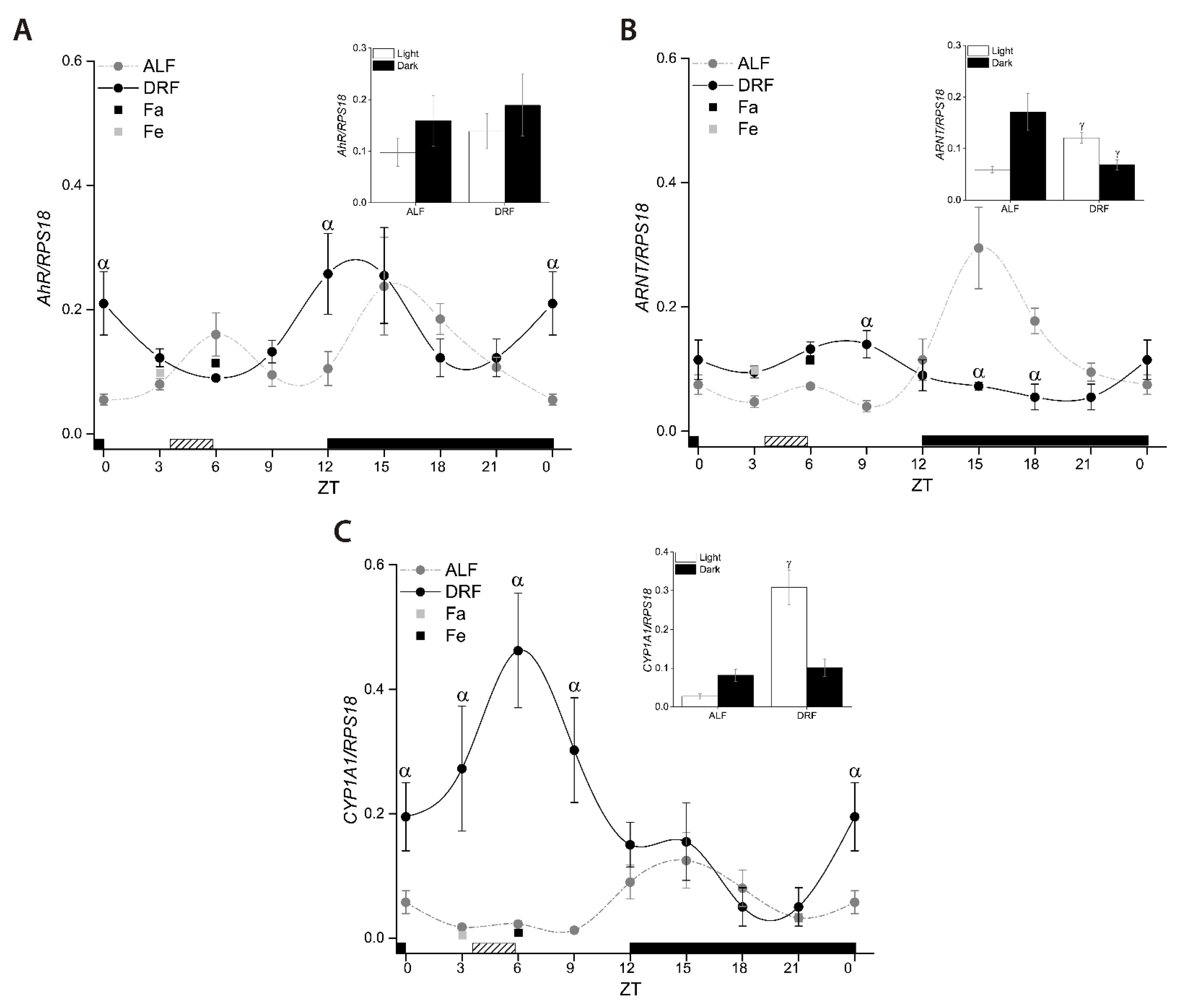
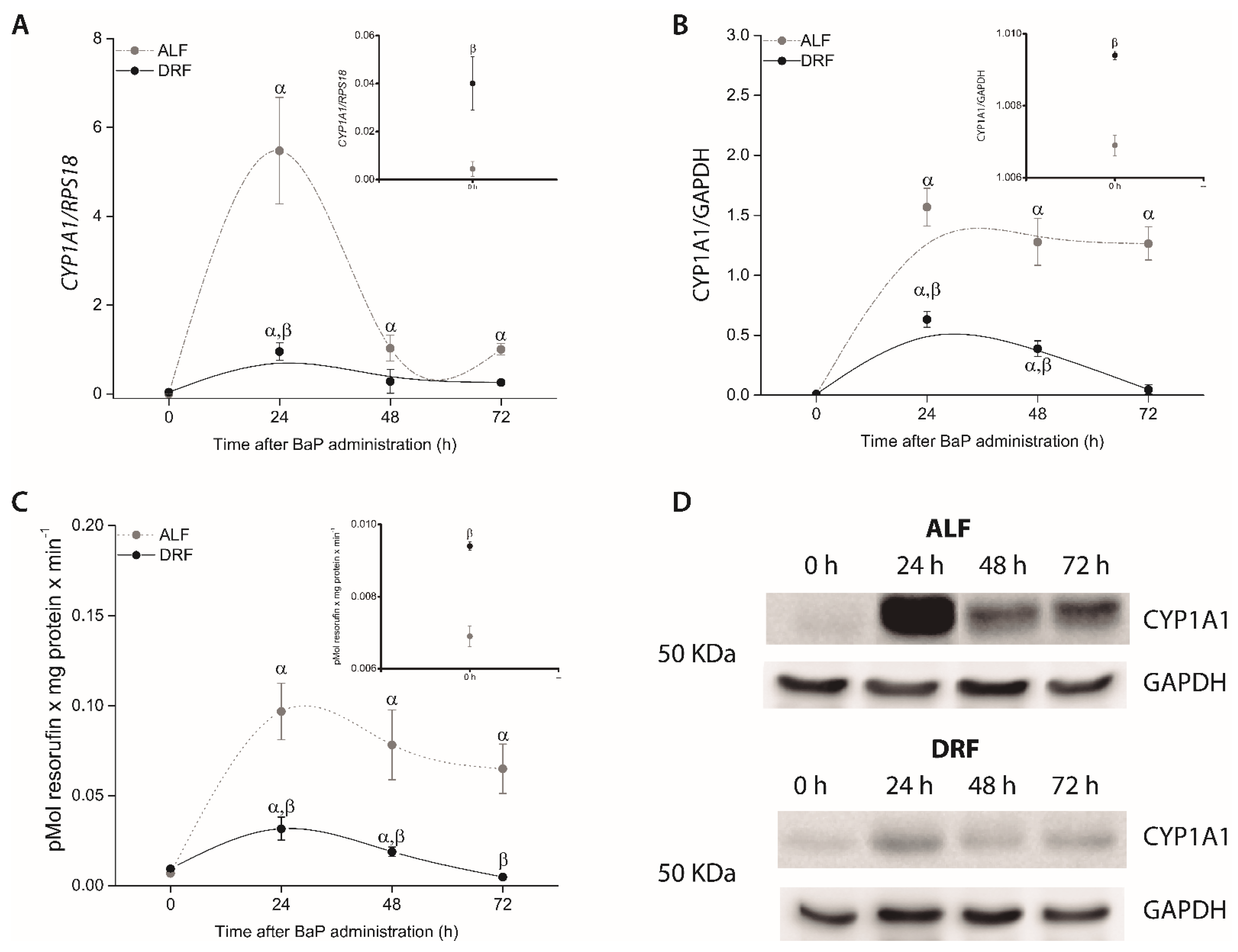
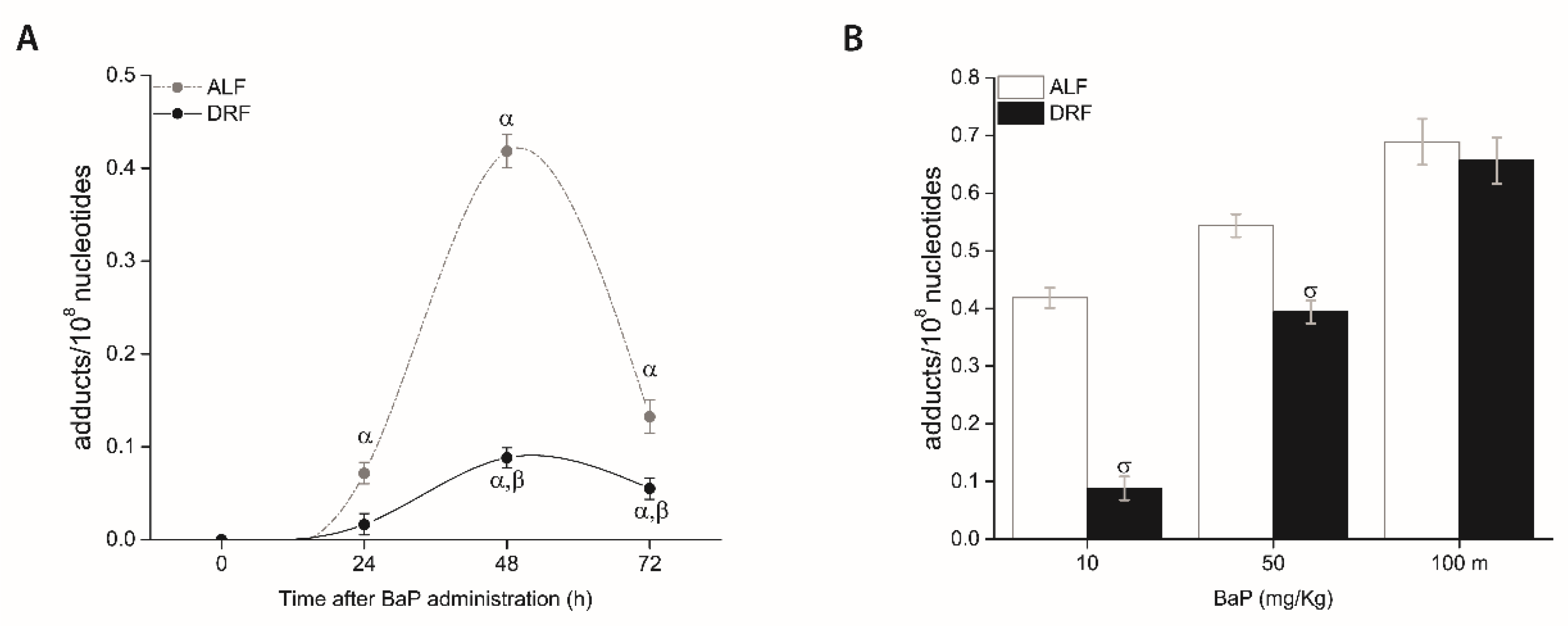
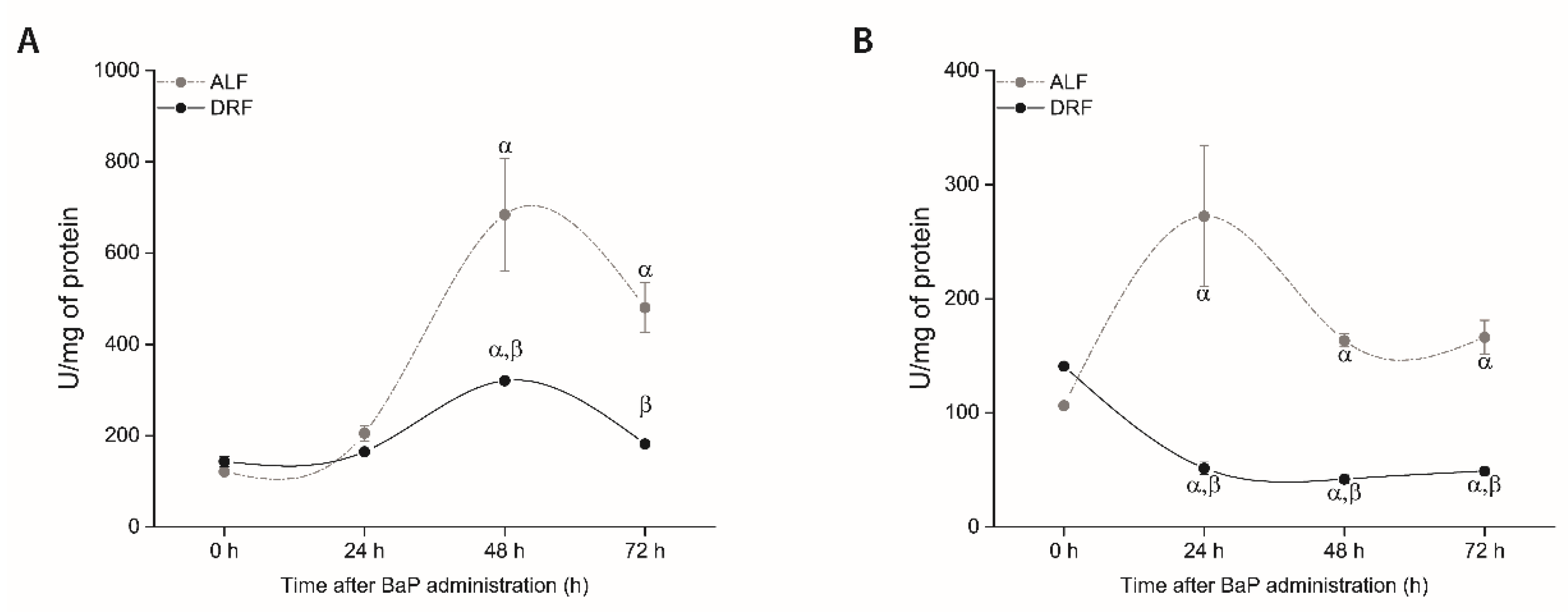
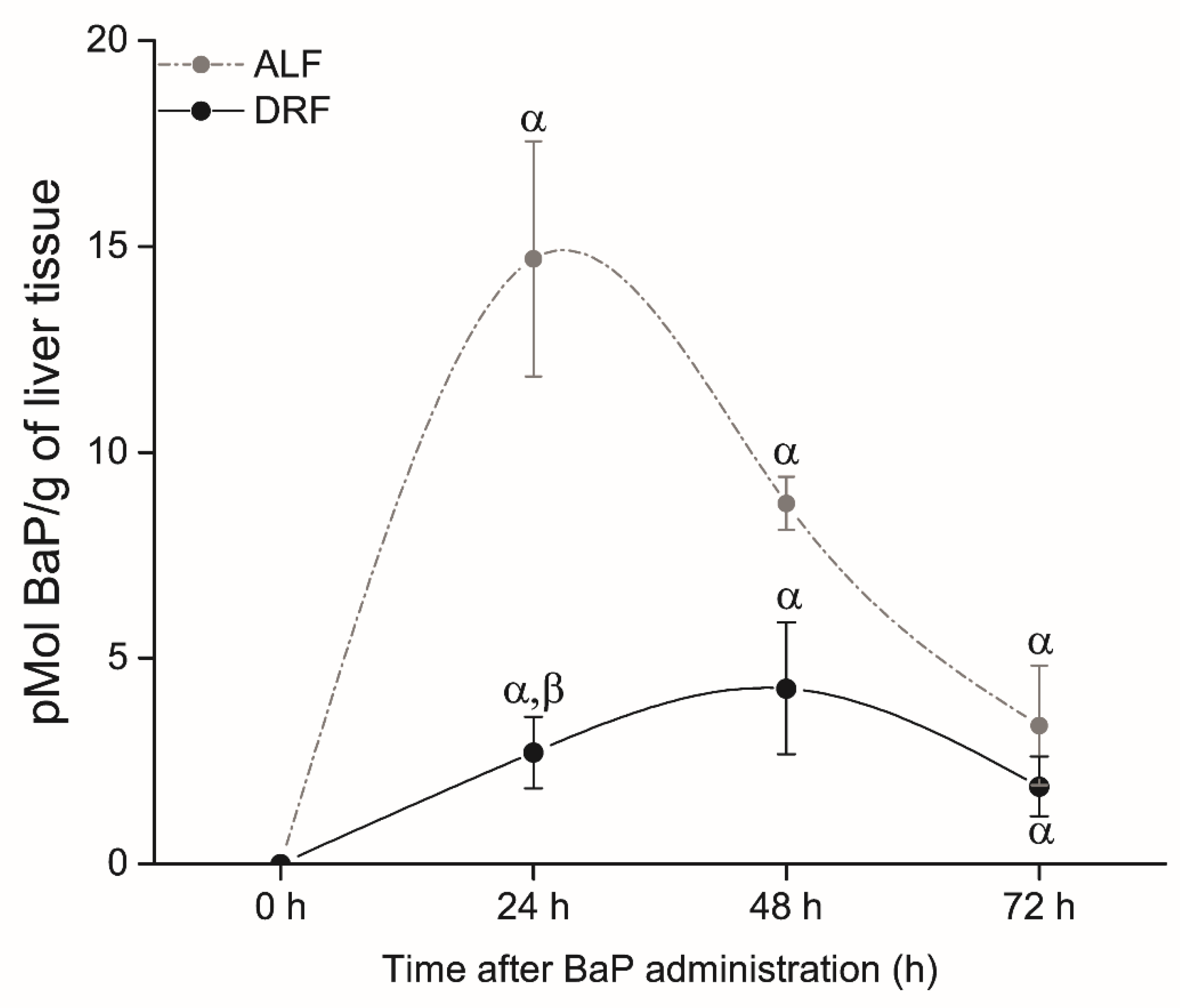
| Gene | NCBI RefSeq | Forward | Reverse |
|---|---|---|---|
| AhR | NM_013149.3 | 5′-gggccaagagcttctttgatg-3′ | 5′-gcaagtcctgccagtctctga-3′ |
| ARNT | NM_012780 | 5′-agagacttgccagggaaaatcata-3′ | 5′-tttcgagccagggcactacagg-3′ |
| CYP1A1 | NM_012540.2 | 5′-gggccaagagcttctttgatg-3′ | 5′-gtcccggatgrggcccttctcaaa-3′ |
| RPS18 | NM_213557.1 | 5′-ttcagcacatcctgcgagta-3′ | 5′-ttggtgaggtcaatgtctgc-3′ |
| Mesor | Amplitude | Acrophase | ||||
|---|---|---|---|---|---|---|
| ALF | DRF | ALF | DRF | ALF | DRF | |
| AhR | 0.128 | 0.164 | 0.091 | 0.084 | ZT14 | ZT14 |
| ±0.014 | ±0.017 | ±0.026 | ±0.027 | ±1.936 | ±2.44 | |
| ARNT | 0.115 | 0.094 | 0.128 | 0.043 | ZT17 | ZT5 |
| ±0.02 | ±0.047 | ±0.03 | ±0.007 α | ±0.75 | ±1.43 α | |
| CYP1A1 | 0.055 | 0.205 | 0.056 | 0.207 | ZT17 | ZT5 |
| ±0.009 | ±0.031 α | ±0.018 | ±0.041 α | ±1.436 | ±3.86 α | |
| Control | Only Corn Oil | |||
|---|---|---|---|---|
| ALF | DRF | ALF | DRF | |
| CYP1A1/RPS18 | 0.0043 ± 0.0003 | 0.0400 ± 0.002 | 0.0046 ± 0.0010 | 0.0394 ± 0.005 |
| CYP1A1 activity (pMol resorufin × mg protein × min−1) | 0.0069 ± 0.0002 | 0.0094 ± 0.0001 | 0.0067 ± 0.0001 | 0.0096 ± 0.0001 |
| ALT U/mg protein | 106.3 ± 1.91 | 141 ± 2.8 | 106.7 ± 2.61 | 140 ± 5.8 |
| AST U/mg protein | 121.5 ± 5.3 | 143.5 ± 10.6 | 125.5 ± 7.2 | 145.2 ± 9.6 |
Publisher’s Note: MDPI stays neutral with regard to jurisdictional claims in published maps and institutional affiliations. |
© 2021 by the authors. Licensee MDPI, Basel, Switzerland. This article is an open access article distributed under the terms and conditions of the Creative Commons Attribution (CC BY) license (https://creativecommons.org/licenses/by/4.0/).
Share and Cite
Ávila-Rosales, O.S.; Díaz-Muñoz, M.; Camacho-Carranza, R.; Coballase-Urrutia, E.; Pedraza-Chaverri, J.; García-Rebollar, J.O.; Espinosa-Aguirre, J.J. Daytime Restricted Feeding Modifies the Temporal Expression of CYP1A1 and Attenuated Damage Induced by Benzo[a]pyrene in Rat Liver When Administered before CYP1A1 Acrophase. Toxics 2021, 9, 130. https://doi.org/10.3390/toxics9060130
Ávila-Rosales OS, Díaz-Muñoz M, Camacho-Carranza R, Coballase-Urrutia E, Pedraza-Chaverri J, García-Rebollar JO, Espinosa-Aguirre JJ. Daytime Restricted Feeding Modifies the Temporal Expression of CYP1A1 and Attenuated Damage Induced by Benzo[a]pyrene in Rat Liver When Administered before CYP1A1 Acrophase. Toxics. 2021; 9(6):130. https://doi.org/10.3390/toxics9060130
Chicago/Turabian StyleÁvila-Rosales, Oscar Samuel, Mauricio Díaz-Muñoz, Rafael Camacho-Carranza, Elvia Coballase-Urrutia, José Pedraza-Chaverri, Jorge Omar García-Rebollar, and Jesús Javier Espinosa-Aguirre. 2021. "Daytime Restricted Feeding Modifies the Temporal Expression of CYP1A1 and Attenuated Damage Induced by Benzo[a]pyrene in Rat Liver When Administered before CYP1A1 Acrophase" Toxics 9, no. 6: 130. https://doi.org/10.3390/toxics9060130
APA StyleÁvila-Rosales, O. S., Díaz-Muñoz, M., Camacho-Carranza, R., Coballase-Urrutia, E., Pedraza-Chaverri, J., García-Rebollar, J. O., & Espinosa-Aguirre, J. J. (2021). Daytime Restricted Feeding Modifies the Temporal Expression of CYP1A1 and Attenuated Damage Induced by Benzo[a]pyrene in Rat Liver When Administered before CYP1A1 Acrophase. Toxics, 9(6), 130. https://doi.org/10.3390/toxics9060130







